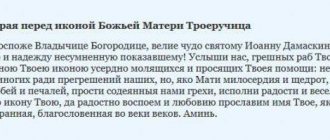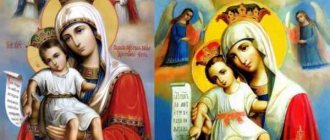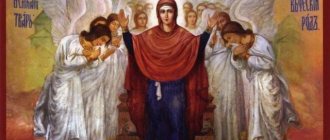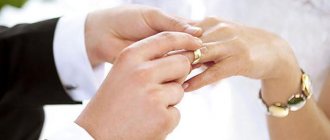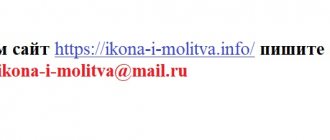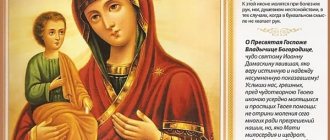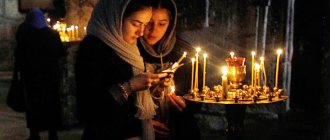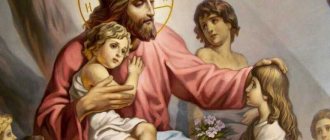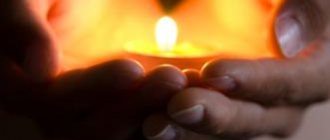What is prayer
The spiritual life of a believer is impossible without communication with God, the Mother of God and the saints. Prayer, including the prayer to the “Three-Handed One,” is a support in troubles and failures, the basis for life’s achievements, and support in the spiritual field. It connects the person praying with the Heavenly Father with an invisible thread. Just as a child rejoices when he sees his parents and talks to them, so it is natural for the soul of a believer to rejoice in communication with God.
Icon of the Mother of God “Three Hands”
“Praying to the Lord does not require special eloquence or emotional excitement. The Lord hears a simple, sincere word coming from a believing heart. Prayer excludes artificiality and falsehood; there is no place for acting. In prayer, we present ourselves before God as we really are and ask Him to cleanse us and make us better. Through prayer we reveal to the Lord all the secrets of our soul, we completely entrust ourselves to His sanctifying power” (priest Valery Dukhanin).
Reading rules
A chant of praise to the glory of the Lord, the Virgin Mary and the Holy Spirit is called an akathist. Each akathist is dedicated to a specific saint and is read in front of his image. The purpose of reading may be problems that this particular saint can help solve. The akathist is also read to find peace.
Akathist is translated as “unsaddled singing.” That is, it should be read standing, facing the image of the “Three-Handed Woman.” Only sick people are allowed to sit. If there is no icon at home, the glorification of the saint can be read in the temple, turning your face to the east. In order to heal the patient, the akathist is read at the head of his bed.
The akathist is read in the same way as prayers. Or rather, the initial prayer is offered first, followed by an akathist. The reading of prayers to the Mother of God should be repeated in the morning and evening. It would not be a mistake to read the akathist without preliminary prayer. The main thing is that the prayer or akathist be read with deep respect and sincere faith.
The iconographic image of “Three Hands” is located in the eastern corner of the room. It is allowed to be installed next to the image of Christ the Savior.
Why pray to the Virgin Mary
Orthodox people pray to the Most Holy Theotokos, trusting in Her help and intercession. It is She who stands closest to God. Jesus Christ especially appreciates and fulfills the requests of the Virgin Mary - His Mother. It is worth remembering the first miracle performed at a wedding in Cana of Galilee. At the request of the Mother of God, the Savior turned wine into water. The numerous miracles performed by the Mother of God most clearly testify to the motherly love of the Mother of God for believers. Orthodox Christians regard the Most Holy Theotokos as a mother. And they expect parental care from Her. We believe that the Virgin Mary will not leave her children without support and help. And the prayer “Three Hands” is one of the appeals to the Mother of God.
“When you see the icon of the Most Holy Theotokos, turn your heart to Her, the Queen of Heaven, and thank Her for the fact that She appeared so ready to submit to the will of God, that she gave birth, “nourished” and raised the Savior of the world, and that in our invisible battle Her intercession and help to us never fails” (Reverend Nicodemus the Holy Mountain).
Description of the image
At the moment, there are several icons of the “Virgin Mary of Three Hands”, but they are all made in accordance with the first image, which, unfortunately, is not kept in Russia. However, at one time several copies were made from it, preserved to this day.
The central place in the icon is occupied by Jesus, sitting in the arms of the Mother of God. With one hand she blesses everyone who approaches the image, and the other is directed towards the Baby. By this, the Mother of God wants to show that for every believer there is a path to salvation, and this path is faith. It can only be found through turning to Jesus.
It is noteworthy that the icon also depicts a third hand. Sometimes it is made of gold and silver, and sometimes it is prescribed in accordance with anatomical details. Sometimes icon painters draw it in such a way that it looks like the third hand of the Virgin Mary. To understand what this image means, it is necessary to study the life story of St. John of Damascus (we will present it in the next section).
The image itself is considered miraculous, and prayer to the Most Holy Theotokos in front of the “Three-Handed” icon can heal many diseases. However, we will talk about this a little later.
History of the Three-Handed Icon
According to legend, the discovery of the “Three-Handed” icon took place in the 8th century. At that time, the Byzantine emperor Leo III the Isaurian was actively fighting against icon veneration. Many icons were destroyed and their defenders were persecuted.
The Monk John of Damascus wrote several letters in defense of icon veneration, which infuriated the emperor. Leo III composed a forged letter in the name of John. He allegedly offered Byzantium to conquer Damascus with his help. After this slander, John of Damascus was expelled from the court of the caliph, and his right hand was cut off. The severed limb was hung in the market square as a warning to the people.
In the evening the severed hand was returned to John. He put it to his hand and began to fervently pray in front of the icon of the Mother of God for healing. Exhausted by physical and spiritual suffering, John fell asleep and had a dream. In it, the Mother of God promised a speedy healing. When the Monk John woke up, he saw that his hand was absolutely healthy. In gratitude for the miracle performed, John cast his right hand from silver and placed it near the image of the Virgin Mary. Since then, the icon began to be called “Three-Handed”.
Later, John of Damascus took monastic vows in the monastery of St. Sava in the Judean desert. He also moved the icon of the Mother of God of the Three Hands there. The icon remained in the holy monastery until the 13th century. Then the image was presented to the Serbian Archbishop Sava. But Serbia was not destined to become the last refuge of the holy image. During the Turkish invasion, the icon was transported to the Athos Hilandar Monastery, where “Three Hands” is still located.
The Three-Handed Icon is also revered in Russian Orthodoxy. A copy of the miraculous icon was sent by Athonite monks in 1661 for the New Jerusalem Monastery under construction. Numerous icons were painted from this image, which found their places in many holy monasteries and churches of Rus'.
Remembrance Day of the Three-Handed Icon - July 25 according to the new style.
Miraculous healing
Having returned his hand, John fell on his knees in front of the image of the Mother of God and began to pray to her for the growth of his hand. He read many prayers and in all of them he ardently regretted that now he could not do anything useful for the Creator. Exhausted from pain, the monk fell asleep and in a dream the Mother of God herself appeared to him. She promised to heal John, but only if he would do his work even more diligently in the name of the Lord.
The next morning, the saint saw that his hand had grown back, and only a barely noticeable scar remained at the site of the wound. This miracle amazed everyone around him, and John of Damascus was released from prison.
Miracles through prayers before the icon
The abbess of the Assumption Feklina Hermitage (Kaluga region) Vitaly (Kochetova) spoke about the miraculous renewal of the face of the ancient icon “Three Hands”. Once she visited the Bulgarian courtyard in honor of the Dormition of the Blessed Virgin Mary in Moscow. The rector of the metochion gave her an old icon, completely blackened. It was completely impossible to make out whose image it was.
After the hermitage arrived in Feklina, the icon was placed in the temple. And over time, the sisters of the monastery began to notice that the icon was gradually appearing. First, the silhouette of the Most Holy Theotokos appeared, then the infant Christ became visible. The sisters were the last to see the third hand on the icon of the Virgin Mary. The icon is still being updated: the expression of the Virgin’s face and the ornament on the robe are changing.
Before the miraculous image, the prayer “Three Hands” is now often heard. After all, the abbess herself received healing from a heart defect. And many pilgrims note that what is asked in front of the icon of the Three-Handed Mother is fulfilled.
One day a girl came to Feklina Pustyn, desperate to find a job. The girl prayed in front of the “Three-Handed One” and asked the Mother of God to help her cope with difficulties and not grumble. Less than half an hour later she received a call with an offer for a well-paid job. The next day there was another offer. The girl was amazed at how quickly the Mother of God responded to sincere prayers.
A miraculous case of salvation from a fire occurred in the Hilandar Monastery in 1945. During the dry summer, a fire broke out near the monastery. The flames inexorably approached the walls of the monastery. The monks decided to make a religious procession around the monastery with the miraculous image of the Most Holy Theotokos. And a miracle happened: the wind abruptly changed direction, the fire did not touch the monastery buildings. This is how the Mother of God saved her monastery.
What do they ask for in front of the holy image?
It is believed that the icon can help cure diseases of the hands and feet. “Three Hands” is also addressed with a prayer for the well-being and health of loved ones. They ask to be protected from enemies. Mothers turn to their Heavenly intercessor when their children stray from the straight path:
- are addicted to drinking and drugs;
- are involved in gambling;
- They become violent and do not recognize or obey their parents.
Before a complex operation or long-term treatment, it is also useful to pray to the “Three Hands”. If faith is strong, prayer is sincere, the intercessor will definitely help. Frequently traveling, sick, and convalescent people should always have the icon of the Mother of God with them.
Prayer to the “Three Hands”
Prayer to the icon of the Mother of God “Three Hands”
Oh, Most Holy Lady and Lady Theotokos, who showed a great miracle to Saint John of Damascus, as if he showed true faith - undoubted hope! Hear us, sinners, before Your miraculous icon, fervently praying and asking for Your help: do not reject this prayer of many for the sake of our sins, but, as the Mother of mercy and generosity, deliver us from illnesses, sorrows and sorrows, forgive the sins we have committed, fill us with joy and joy to all who honor Your holy icon, may we joyfully sing and glorify Your name with love, for You are chosen and blessed from all generations forever and ever. Amen.
Troparion
Today, great worldwide joy has arisen for us: Thy celibate-bearing icon has been given to the holy Mount Athos, the Lady Theotokos, with the image of Thy three-numbered and indivisibly most pure hands, for the glorification of the Holy Trinity, calling for the faithful and those who pray to You to know this, as two imashes you hold the Son and the Lord , the third, show as a refuge and protection to those who honor You from all misfortunes and troubles, so that all who flow to You by faith, receive abundant liberation from all evils, protection from enemies, for this sake we, together with Athos, cry out: Rejoice, Gracious One, Lord with you.
Kontakion
Today is the joyful day of Your triumph, O Most Pure Mother of God, all the faithful are filled with joy and joy, as if you were worthy to fairly sing the wondrous appearance of Your honorable image and the Child born of You, the truth of God, Who embraced His two hands, and with the third took us away from misfortunes and troubles and deliver you from all evils and circumstances.
What types of prayer services are there?
There are three types of prayer:
- simple
- prayer service with blessing of water
- prayer service with akathist
Any prayer service begins with the priest shouting and singing a prayer to the Holy Spirit “Heavenly King.” Then the litany is pronounced, troparia on “God is the Lord,” chants are sung, the Gospel and, in some cases, the Apostle are read. After the Gospel, the priest pronounces a special litany, in which he lists the names of those present at the prayer service and their relatives, whose names are written in the notes.
The prayer service with the blessing of water differs from the usual one in that the rite of small blessing of water is added to the usual prayers. It is called “small” in contrast to the “Great Blessing of Water,” which occurs only twice a year: January 18 on Epiphany Eve and January 19, on the feast of the Epiphany.
If you order a prayer service with blessing of water, be sure to take with you a vessel with water for blessing. For this purpose, it is better to take a jar, can or bottle with a wide neck. According to the rite of blessing of water, the priest must immerse the Cross in a vessel with water, and with a narrow neck this is practically impossible to do.
You can drink water from the prayer service throughout the day, add it to food, sprinkle it on your living quarters, and wash your face.
A prayer service with an akathist is an ordinary or water-blessed prayer service, to which the reading of an akathist is added. It is served on patronal feast days, before especially revered icons, holy relics, or when there is a need for special prayer.
How to write a note for a prayer service
You can submit a note for a prayer service by applying for a candle box in the church in which the prayer service will be served.
On the piece of paper at the top you need to draw an Orthodox cross (four, six or eight-pointed). Below we write the word “Prayer” and indicate to whom “the icon of the Mother of God of the Three-Handed One.”
In modern churches, they give out ready-made forms on which a cross is drawn, and sometimes the word “Prayer” is printed. You can also download and print the note form from the Internet.
Rules for filling out a note:
- Only living, baptized Orthodox Christians are allowed to be remembered at the prayer service.
- Commemoration of heretics, unbaptized people, and people of other faiths is not allowed.
- You need to write the full names given at Baptism in the genitive case: Anna, Victor, Vladimir.
- Children under seven years of age are called infants: ml. Anastasia, Jr. Theodora.
- From seven to fifteen years old they are called a youth, a young woman: neg. Maxima, neg. Maria.
- You can also write before the name: warrior, sick, prisoner.
- They write about pregnant women: not idle or pregnant.
- There is no need to write: lost, angry, drinking, and the like.
- If one of your friends or relatives has a non-Christian name, find out what name they were baptized with. Some people have two names: one non-Christian, received from their parents at birth, and the other, which was given by the priest at baptism, in honor of an Orthodox saint. But you should know that many Christian names in local churches (for example, Georgian) sound unusual to the Russian ear, but they can be indicated in notes.
- Notes must be written in clear, legible handwriting. During the prayer service, the priest has to read dozens of notes. Why complicate his conditions by forcing him to disassemble the encryption?
- One note usually contains no more than 10 names.
- If you want to remember as many people as possible, you can write Anna and your children. (children), Vladimir and his birth. (relatives).
- Before the names of the clergy, their rank is indicated: Priest Evgeniy, Archpriest Vyacheslav, Bishop. (Bishop Alypius).
- They do the same with the names of monastics: mon. Sergius, monk. Alexandra, last Lyudmila, abbot. Benedicta, schiarch. Evgenia.
